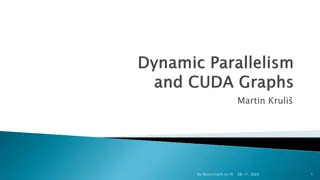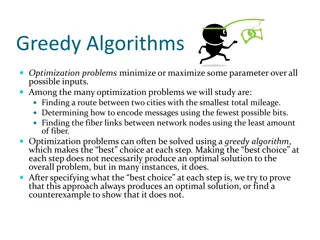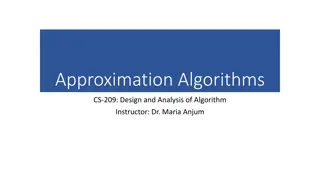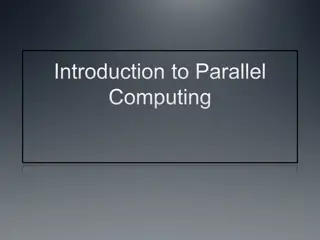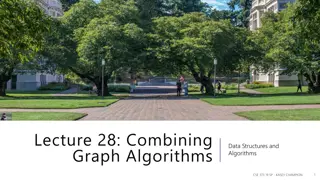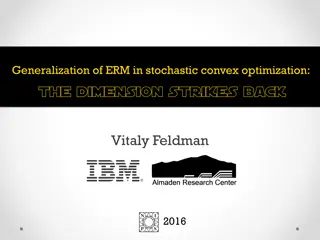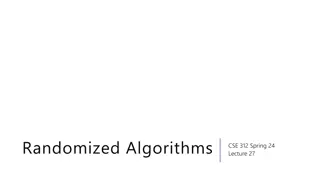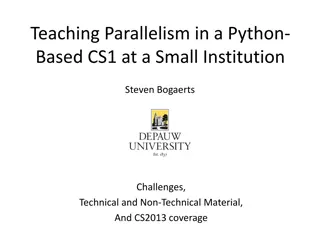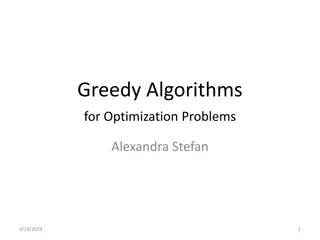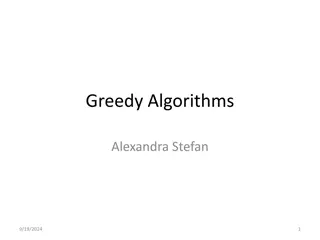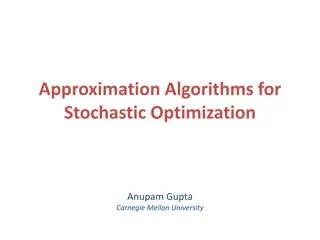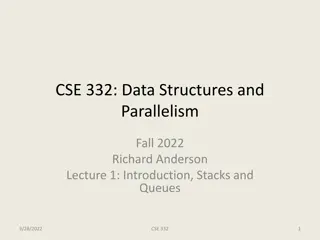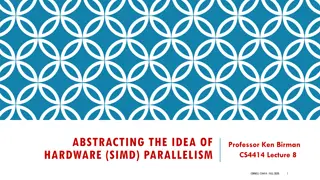Parallelism and Optimization in Algorithms
Explore the concepts of Amdahl's Law, Moore's Law, and clever parallel algorithms to enhance performance and efficiency. Discover the benefits of designing smarter algorithms and parallelizing code to overcome bottlenecks and improve processing speed in multi-pass data structures.
Download Presentation

Please find below an Image/Link to download the presentation.
The content on the website is provided AS IS for your information and personal use only. It may not be sold, licensed, or shared on other websites without obtaining consent from the author.If you encounter any issues during the download, it is possible that the publisher has removed the file from their server.
You are allowed to download the files provided on this website for personal or commercial use, subject to the condition that they are used lawfully. All files are the property of their respective owners.
The content on the website is provided AS IS for your information and personal use only. It may not be sold, licensed, or shared on other websites without obtaining consent from the author.
E N D
Presentation Transcript
Multi-Pass Data Structures and Parallelism Parallel Algorithms
Recall: Amdahls Law With just some algebra we showed: ?1 ?? 1 ?+1 ? ? and ?1 ? 1 ?
Amdahls Law and Moores Law In the Moore s Law days, 12 years was long enough to get 100x speedup. Suppose in 12 years, the clock speed is the same, but you have 256 processors. What portion of your program can you hope to leave unparallelized? 1 100 ?+1 ? 256 [wolframalpha says] ? 0.0061.
Amdahls Law: Moving Forward Unparallelized code becomes a bottleneck quickly. What do we do? Design smarter algorithms! Consider the following problem: Given an array of numbers, return an array with the running sum 3 3 7 7 6 6 2 2 4 4 3 3 10 10 16 16 18 18 22 22
Sequential Code output[0] = input[0]; for(int i=1; i<arr.length;i++){ output[i] = input[i] + output[i-1]; }
More clever algorithms Doesn t look parallelizable But it is! Algorithm was invented by Michael Fischer and Richard Ladner -Both were in UW CSE s theory group at the time -Richard Ladner is still around -Look for a cowboy hat For today: I m not going to worry at all about constant factors. Just try to get the ideas across.
Parallelizing What do we need? Need to quickly know the left sum i.e. the sum of all the elements to my left. -in the sequential code that was output[i-1] We ll use two passes, The first sets up a data structure -Which will contain enough information to find left sums quickly The second will assemble the left sum and finish the array.
Sum: Left sum: Sum: Left Sum: Sum: Left Sum: Sum: Left Sum: Sum: Left Sum: Sum: Left Sum: Sum: Left Sum: S: L: S: L: S: L: S: L: S: L: S: L: S: L: S: L: 6 6 4 4 16 16 10 10 16 16 14 14 2 2 8 8
Sum: Left sum: Sum: Left Sum: Sum: Left Sum: Sum: 10 Left Sum: Sum: Left Sum: Sum: Left Sum: Sum: Left Sum: S: L: S: L: S: L: S: 6 L: S: 4 L: S: L: S: L: S: L: 6 6 4 4 16 16 10 10 16 16 14 14 2 2 8 8
Sum: 76 Left sum: Sum: 36 Left Sum: Sum: 40 Left Sum: Sum: 10 Left Sum: Sum: 26 Left Sum: Sum: 30 Left Sum: Sum: 10 Left Sum: S: 16 L: S: 2 L: S: 8 L: S: 6 L: S: 4 L: S: 16 L: S: 14 L: S: 10 L: 6 6 4 4 16 16 10 10 16 16 14 14 2 2 8 8
First Pass Calculating those sums is the end of the first pass. How long does it take in parallel? Work: Span: Remember work is the running time on one processor. span is the running time on infinitely many processors.
First Pass Calculating those sums is the end of the first pass. How long does it take in parallel? Work: ?(?) Span:?(log?) Just slightly modify our sum reduce code to build the data structure.
Your left child gets your left sum. Your right child has a left sum of: Your left sum + its sibling s sum. Sum: 76 Left sum: 0 Sum: 36 Left Sum: 0 Sum: 40 Left Sum:0+36=36 Sum: 10 Left Sum: Sum: 26 Left Sum: Sum: 30 Left Sum: Sum: 10 Left Sum: S: 16 L: S: 2 L: S: 8 L: S: 6 L: S: 4 L: S: 16 L: S: 14 L: S: 10 L: 6 6 4 4 16 16 10 10 16 16 14 14 2 2 8 8
Your left child gets your left sum. Your right child has a left sum of: Your left sum + its sibling s sum. Sum: 76 Left sum: 0 Sum: 36 Left Sum: 0 Sum: 40 Left Sum:0+36=36 Sum: 10 Left Sum: 0 Sum: 26 Left Sum: 10 Sum: 30 Left Sum: 36 Sum: 10 Left Sum: 66 S: 16 L: 10 S: 2 L: 66 S: 8 L: 68 S: 6 L: 0 S: 4 L: 6 S: 16 L: 36 S: 14 L: 52 S: 10 L: 26 6 6 4 4 16 16 10 10 16 16 14 14 2 2 8 8
Second Pass Once we ve finished calculating the sums, we ll start on the left sums. Can we do that step in parallel? YES! Why are we doing two separate passes? Those sum values have to be stored and ready. Second pass has: Work: Span:
Second Pass Once we ve finished calculating the sums, we ll start on the left sums. Can we do that step in parallel? YES! Why are we doing two separate passes? Those sum values have to be stored and ready. Second pass has: Work:?(?) Span:?(log?)
Third Pass What s our final answer? Our sequential code said element i of the new array should be arr[i] + output[i-1] Or equivalently arr[i] + left_sum[i] Just need one more map using the data structure.
Your left child gets your left sum. Your right child has a left sum of: Your left sum + its sibling s sum. Sum: 76 Left sum: 0 Sum: 36 Left Sum: 0 Sum: 40 Left Sum:0+36=36 Sum: 10 Left Sum: 0 Sum: 26 Left Sum: 10 Sum: 30 Left Sum: 36 Sum: 10 Left Sum: 66 S: 16 L: 10 S: 2 L: 66 S: 8 L: 68 S: 6 L: 0 S: 4 L: 6 S: 16 L: 36 S: 14 L: 52 S: 10 L: 26 6 6 6 6 4 4 10 10 16 16 26 26 10 10 36 36 16 16 52 52 14 14 66 66 2 2 68 68 8 8 76 76
Analyzing Parallel Prefix What s the Work? Span? First pass was a slightly modified version of our sum reduce code. Second pass had a similar structure Third pass was a map
Analyzing Parallel Prefix What s the Work ?(?) Span ?(log?) First pass was a slightly modified version of our sum reduce code. Second pass had a similar structure. Third pass was a map.
Parallel Pack (aka Filter) You want to find all the elements in an array meeting some property. And move ONLY those into a new array. Input: 6 6 4 4 16 16 10 10 16 16 14 14 2 2 8 8 Want every element >= 10 Output: 16 16 10 10 16 16 14 14
Parallel Pack Easy do a map to find the right elements Hard How do you copy them over?
Parallel Pack Easy do a map to find the right elements Hard How do you copy them over? I need to know what array location to store in, i.e. how many elements to my left will go in the new array.
Parallel Pack Easy do a map to find the right elements Hard How do you copy them over? I need to know what array location to store in, i.e. how many elements to my left will go in the new array. -Use Parallel Prefix!
Parallel Pack Step 1: Parallel Map produce bit vector of elements meeting property 6 6 4 4 16 16 10 10 0 0 0 0 1 1 1 1 16 16 1 1 2 2 0 0 14 14 1 1 8 8 0 0 Step 2: Parallel prefix sum on the bit vector 0 0 0 0 1 1 2 2 3 3 3 3 4 4 4 4 Step 3: Parallel map for output. 16 16 10 10 16 16 14 14
Step 3 How do we do step 3? i.e. what s the map? if(bits[i] == 1) output[ bitsum[i] 1] = input[i];
Parallel Pack We did 3 passes: A map A prefix And another map. Work: Span: Remark: You could fit this into 2 passes instead of 3. Won t change O().
Parallel Pack We did 3 passes: A map A prefix And another map. Work: ?(?) Span: ?(log?) Remark: You could fit this into 2 passes instead of 3. Won t change O().
Four Patterns We ve now seen four common patterns in parallel code 1. Map 2. Reduce 3. Prefix 4. Pack (a.k.a. Filter)
Parallelizing Quick Sort Quicksort(){ pick a pivot partition array such that: left side of the array is less than pivot pivot in middle right side of array is greater than pivot recursively sort left and right sides. }
Quick Analysis Note For all of our quick sort analysis, we ll do best case. The average case is the same as best case. Worst case is still going to be the same (bad) ?2 with parallelism or not.
Parallelizing Quick Sort Step 1: Make the recursive calls forks instead of recursion. What is the new (need some recurrences) Work? Span?
Parallelizing Quick Sort Step 1: Make the recursive calls forks instead of recursion. What is the new (need some recurrences) ? 2 Work? ?1? = 2?1 + ?1 ? if ? cutoff if ? < cutoff ?2 ? 2+ ?1 ? if ? cutoff if ? < cutoff Span? ? ? = ? ?2
Parallelizing Quick Sort Step 1: Make the recursive calls forks instead of recursion. What is the new (need some recurrences) Work? ?1? = (?log?) Span? ? ? = ?
Parallel Quick Sort With infinitely many processors, we can speed up quicksort from (? log?)to (?). So yeah . We can do better! In exchange for using auxiliary arrays (i.e. a not in-place sort). Probably not better today. But maybe eventually
Parallel Quick Sort The bottleneck of the code isn t the number of recursive calls It s the amount of time we spend doing the partitions. Can we partition in parallel? What is a partition? It s moving all the elements smaller than the pivot into one subarray And all the other elements into the other
Better Parallel Quick Sort Sounds like a pack! (or two) Step 1: choose pivot Step 2: parallel pack elements smaller than pivot into the auxiliary array Step 3: parallel pack elements greater than pivot into the auxiliary array Step 4: Recurse! (in parallel)
Better Parallel Quick Sort What is (a recurrence for) The work? The span?
Better Parallel Quick Sort What is (a recurrence for) ? 2 The work: T1n = 2?1 + ?1 ? if ? cutoff if ? < cutoff ?2 ? 2 The span: ? ? = ? + ?1 log? if ? cutoff if ? < cutoff ?2
Better Parallel Quick Sort What is (a recurrence for) The work: (?log?) The span: (log2?)
Parallel Merge Sort How do we merge? Find median of one array. (in ? 1 time) Binary search in the other to find where it would fit. Merge the two left subarrays and the two right subarrays -In parallel! Only need one auxiliary array Each recursive call knows which range of the output array it s responsible for. Key for the analysis: find the median in the bigger array, and binary search in the smaller array.
Parallel Merge 0 0 4 4 6 6 8 8 9 9 1 1 2 2 3 3 5 5 7 7 6 6 8 8 9 9 0 0 4 4 1 1 2 2 3 3 5 5 7 7 Find median of larger subarray (left chosen arbitrarily for tie) Binary search to find where 6 fits in other array Parallel recursive calls to merge
Parallel Merge 0 0 4 4 6 6 8 8 9 9 1 1 2 2 3 3 5 5 7 7 6 6 8 8 9 9 0 0 4 4 1 1 2 2 3 3 5 5 7 7 7 7 6 6 8 8 0 0 4 4 3 3 5 5 9 9 1 1 2 2 Find median of larger subarray (left chosen arbitrarily for tie) Binary search to find where 6 fits in other array Parallel recursive calls to merge
Parallel Merge 0 0 4 4 6 6 8 8 9 9 1 1 2 2 3 3 5 5 7 7 6 6 8 8 9 9 0 0 4 4 1 1 2 2 3 3 5 5 7 7 7 7 6 6 8 8 0 0 4 4 3 3 5 5 9 9 1 1 2 2 8 8 7 7 6 6 3 3 5 5 0 0 1 1 4 4 9 9 2 2 Find median of larger subarray (left chosen arbitrarily for tie) Binary search to find where 6 fits in other array Parallel recursive calls to merge
Parallel Merge 0 0 4 4 6 6 8 8 9 9 1 1 2 2 3 3 5 5 7 7 6 6 8 8 9 9 0 0 4 4 1 1 2 2 3 3 5 5 7 7 7 7 6 6 8 8 0 0 4 4 3 3 5 5 9 9 1 1 2 2 8 8 7 7 6 6 3 3 5 5 0 0 1 1 4 4 9 9 2 2 0 0 1 1 2 2 3 3 4 4 5 5 6 6 7 7 8 8 9 9
Parallel Merge Sort Let s just analyze the merge: What s the worst case? One subarray has of the elements, the other has . This is why we start with the median of the larger array. 3? 4 ? 4+ ? log? if ? cutoff if ? < cutoff Work: T1n = ?1 + ?1 ?2 3? 4 Span: ? ? = ? + ? log? if ? cutoff ?2 if ? < cutoff
Parallel Merge Sort Let s just analyze the merge: What s the worst case? One subarray has of the elements, the other has . This is why we start with the median of the larger array. Work: T1n = ? ? Span: ? ? = ? log2?
Parallel Merge Sort Now the full mergesort algorithm: ? 2+ ? ? Work: T1n = 2?1 if ? cutoff ?2 if ? < cutoff ? 2+ ? log2? Span: ? ? = ? if ? cutoff ?2 if ? < cutoff
Parallel Merge Sort Now the full mergesort algorithm: Work: T1n = (?log?) Span: ? ? = log3?
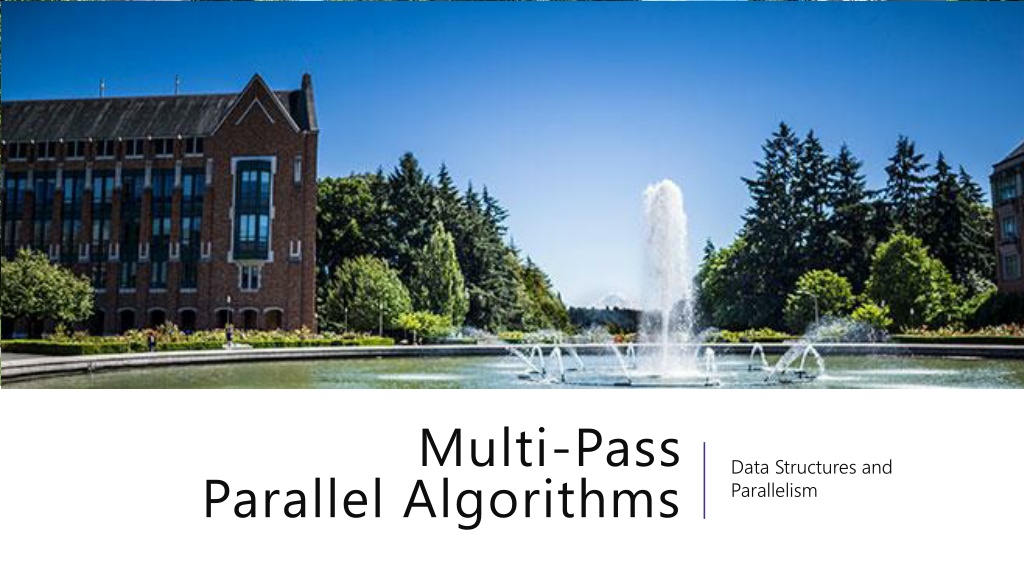
 undefined
undefined
